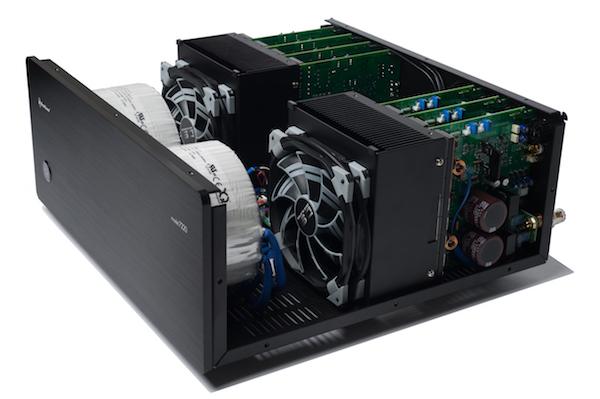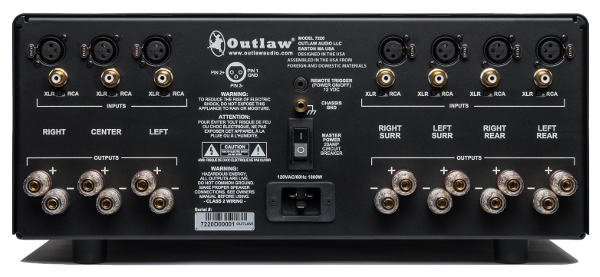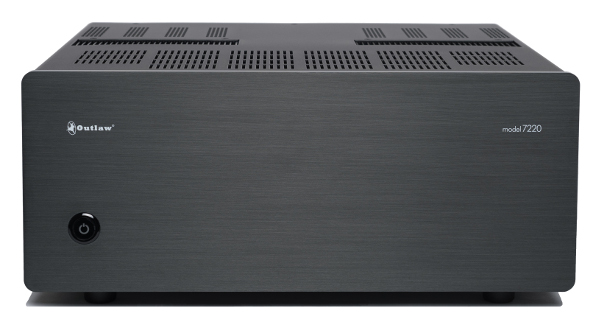Living With Outlaw Audio's Latest Seven-Channel Amp

Looking...
Outlaw’s latest 7-channel amp is the 7220, the flagship of their current lineup. They sent me a sample to have a look and listen. It features seven class A/B channels rated at 220 W per channel (thus the model number) into 8 ohms and 300W per channel into 4 ohms, with all channels driven. The amp’s cooling is assisted by a fan whose speed varies with the need; from little more than six feet away I never heard it operating. Both single-ended and balanced inputs are individually selectable for each channel. The amp’s two jumbo toroidal transformers contribute significantly to its back-breaking weight of 93 lbs.
To get the most from this amp a 20 Amp circuit would be ideal. The 7220 hints at this as it’s fitted with an unusual IEC power connector, with its ground leg blade-shaped rather than rounded as is more common. A compatible IEC power cord is included. I don’t have a 20-amp circuit, so the usual 15-amp had to do. But since I never listen at levels that metal-heads demand (though I often do crank movies to levels the average civilian would consider unsettling) this didn’t appear to be a limiting factor in my listening. In any case it’s unlikely you’ll be driving all seven channels to their maximum capability simultaneously. In fact, I feel it’s overkill to have 220W on tap for all seven channels. But I’m no market analyst; consumers well might turn up their noses at a 7-channel amp with only three of the channels (for the front speakers) capable of the full 220W.
The 7220’s marquee feature is its fully balanced configuration from input to output. This is rare in amp design; most often an amp’s balanced inputs are converted internally to single ended operation. The benefit of using a balanced connection in the latter case is a reduction in possible noise pickup in a long interconnect run from preamp to amp vs. the more common unbalanced cable. A fully balanced amp should further improve on this. With the 7220 in my setup, noise from the speakers was totally inaudible even with my ear pressed against the tweeter grille. In theory a fully balanced design might offer other sonic benefits as well. But those might be hard to confirm without comparison to another amp identical in all other respects apart from not having a balanced configuration.

But while the fully-balanced, solidly engineered accomplishment here is impressive, it comes with downsides. It would seem that to fully benefit from it the source must also be fully balanced, and I don’t know of any AV pre-pros that claim that type of design. There may be 2-channel preamps that offer it, but I don’t believe that many 2-channel-only audiophiles are looking for a 7-channel amp. Nevertheless, for this test I did all of my listening through the 7220’s balanced inputs, fed from my Marantz AV8805 pre-pro that makes no claim for a fully balanced configuration (though I use only its digital coaxial input for 2-channel music and its HDMI input for movies).
The 7220 is also expensive relative to its current multichannel (but not fully-balanced) competition. The 7220 has undergone a considerable price increase since first introduced roughly 2-years ago. Launched at $2,299, it’s currently $3,499. At least some of this is due to recently introduced tariffs on products from China. I don’t know how much of this is the case, but while the amp is assembled in the USA, the parts come largely from Asia, most likely from China. At its introduction it was a steal, but even at its current price it remains highly competitive.
Listening...
Used full range, driving my Monitor Audio Silver 10s in 2-channel stereo with Audyssey engaged (to eliminate the significant midbass emphasis that my room and setup, the latter constrained by the position of the screen, adds to most full-range speakers), the bass was clean, crisp, and tight. It wasn’t jaw dropping, but that’s no reflection on the amp. In my experience Audyssey tends to lean out the bass, and the Audyssey Editor App, which in theory allows user compensation for this or other possible issues, failed to respond to my attempts to dial in a 3-4 dB boost below 80Hz. It’s possible that in flattening both the midbass hump and the speakers’ deep bass rolloff below that in my room, Audyssey was using up all the EQ at its disposal. Either that or its operating parameters constrain it from doing additional low-end boost beyond what was already in use to flatten the low end. Further boosting might overdrive the speakers and/or the an amp, the capability of each being unknown to Audyssey (another reason why AV8805’s tone controls are unavailable with Audyssey engaged!).

I therefore did most of my listening to the 7220 with two SVS SB-3000 subs engaged. The midbass issue was solved here not with Audyssey but by using the same technique described in my recent review of the Revel F226Be speaker system dialing down the Marantz AV8805 pre-pro’s bass control to between -4 and -6 (which flattens the midbass hump, at least in my setup) and setting the subwoofer level high enough to restore the overall low end balance. (The AV8805’s bass control does not affect its subwoofer channel.)
Used in this way, the Outlaw 7220 offered superb performance, both on 2-channel music and on movies with five of its channels driven (I used that old Outlaw Model 750 amp to drive all four of my four overhead Dolby Atmos speakers, when needed, as mentioned earlier). It did sound a bit different from my current resident 5-channel Parasound Halo 52+ amplifier reviewed by Sound & Vision editor Al Griffin, though neither better nor worse. The Outlaw sounded a little warmer and richer but with no lack of fine detail, the Parasound a bit crisper and airier but in no way edgy or bright. These differences could be argued about, and will by those who contend that all competent amplifiers sound alike (a heated topic that will never end), and I won’t declare here that either amp is the absolute best of the two. Both are outstanding, and comparable in price on a per-channel basis. The Outlaw has more channels if you need them and is a bit more solidly built in some ways, such as its impressive dual toroidal transformers and more upmarket speaker outputs. The Parasound is cheaper if 5-channels are sufficient, has about 18% less specified power into 8 ohms, and is roughly half the weight the latter important mainly to those who constantly feel the need to move their amps around (like reviewers!).
While the Outlaw 7220’s price has increased since its introduction, for whatever reasons, I’m confident it can compete with any amp on the market at its price or even higher.





























































